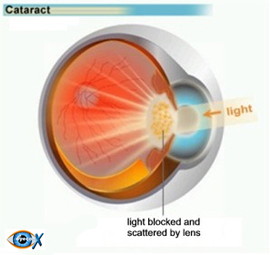Cataracts
A cataract occurs when there is progressive clouding of the normally clear lens within the eye. This results in impaired or dimmed vision. The exact cause of cataracts is unknown. However, researchers believe that a chemical change in the eye causes proteins to form opacities or clumps that cloud the lens. As the opacity grows it inhibits the passage of light distorting vision.
Since the clouding of the lens is gradual cataracts affect people over 55 years old. It is one of the most common conditions related to aging but cataracts can affect younger people as well. They rarely affect infants but when they do it is usually the result of an infection during pregnancy such as rubella or syphilis. Cataracts can also result from diseases such as diabetes from injury from certain types of medication such as steroids or they can be hereditary. Some researchers believe that the risk of developing cataracts increases with excessive exposure to ultraviolet radiation extreme alcohol consumption and cigarette smoking.
Symptoms
Although cataracts usually develop without discomfort there are often indications that one may be forming. Symptoms include:
- Blurry or filmy vision
- Increased sensitivity to light and glare
- Double vision or poor night vision
- Distorted colours.
- Temporary improvement in nearsighted vision commonly known as second sight.
- Treatment
There is currently no proven method to prevent the formation of cataracts. Most eyecare practitioners recommend wearing sunglasses on sunny days and some propose lifestyle changes such as a diet high in antioxidants that includes vitamins C E beta-carotene and lutein moderate to low alcohol consumption and no smoking. An optometrist can diagnose a cataract monitor its development and prescribe necessary changes in glasses or contact lenses to maintain adequate vision.
If the cataract progresses to the point that it seriously impairs vision and affects daily activities cataract surgery is a relatively simple and painless process that can help restore vision. Recent statistics indicate that surgeons perform over 1.5 million cataract surgeries each year in North America and that 90 per cent of surgery patients regain some vision. The surgery entails the removal of the eye s natural lens and of replacement of an artificial plastic intraocular lens (IOL). If both eyes are affected the surgeon will operate on different days.



